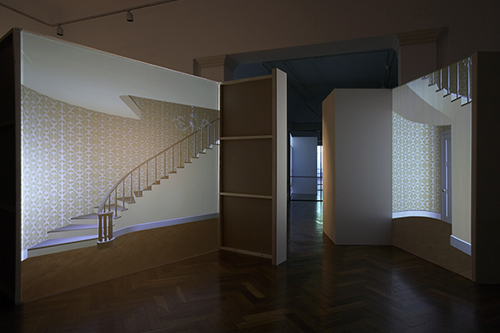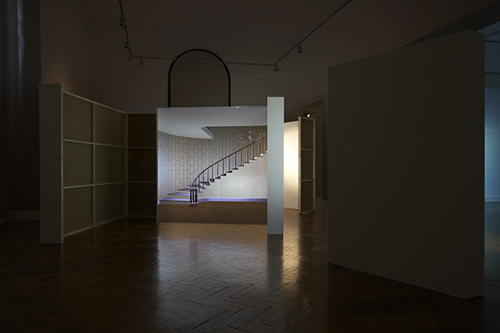[2007] Grand Staircase (Contemporary Retro)
Wood construction, paint, two transparent projection screens, three computer-generated animations transferred to DVD, one 16:9 monitor
Dimensions variable (approx. 850 x 610 x 225 cm)
"[...] While the architectural elements cited in the Executive Office (Contemporary Modern) and Grand Staircase (Contemporary Retro) installations go back to different formal vocabularies of style, in the context of the TV series they serve one and the same purpose: to exploit the symbolic power of architecture for the purpose of representing and demonstrating power and social influence. And the artist's research also reveals that the choice of architectural style for the locations of popular TV series productions is taken according to certain, recurrent patterns: more neo-classical historicized interiors are usually preferred for private home scenes, for example, while a more modernist contemporary styling usually predominates for offices and corporate headquarters. This would seem to correspond to the often stereotyped allocation of a "cool, sober aesthetic" to modernism and a "decorative opulence" to historicism and historicizing forms. At the same time, any design that draws on the formal vocabulary of style from the nineteenth century might also make reference to the middle-class values of this era, one that was characterized mainly by industrialization and high capitalism. [...]
As in other television productions, Dallas drew on the symbolic content and effect of architecture that served to express social and economic power. By going back to this 1980's series, the artist also refers to the topical relevance of certain visual contexts that have been deployed by the film industry for decades: Even though the series was created as a foil to a specific era of financial prosperity, the power structures it portrays still today bear certain parallels to the current economic and political climate.
The effects of architecture on society have long been disregarded in sociology and architectural theory, with well-founded studies and publications on these topics only recently published, particularly in the German-speaking world (Joseph Maran, 2006). The topicality then of Karina Nimmerfall's work is therefore also due to the fact that she deals with this socially virulent issue at the level of artistic and aesthetic analysis. [...]" - Gabriele Spindler
< Index



